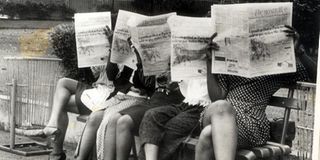A glass half empty: 25 years of Daily Monitor

Ladies read The Monitor at the National Theatre, Kampala, in 1997. The Monitor has reported on the history of Uganda under the NRM government as well as reporting crucial developments in Africa’s Great Lakes. FILE PHOTO
What you need to know:
Silver jubilee. The Monitor was part of the collective media, academia and civil society effort that sought to raise questions about the NRM period just when the Museveni government was starting to gain regional and international credibility, Timothy Kalyegira writes.
Twenty five years ago, July 24, 1992, the first copy of a new weekly national newspaper called The Monitor hit the streets of Kampala.
It would be the start of 25 years of a publication that would report on the history of Uganda under the NRM government of President Yoweri Museveni, as well as reporting crucial developments in Africa’s Great Lakes from Rwanda to the Democratic Republic of Congo and Burundi.
The Daily Monitor was part of the collective media, academia and civil society effort that sought to raise questions about the NRM period just when the Museveni government was starting to gain regional and international credibility.
At that time the mood among the national elite was still relatively positive.
The UPC and opinion leaders from northern Uganda were viewed with disgust as poor losers without the moral authority to comment on Ugandan affairs.
After all, in to many people the UPC governments of Milton Obote had been the architect of much of Uganda’s post-independence history and northerners were viewed as the violent people who had plunged Uganda into political turmoil.
In the meantime, Museveni continued to go through the motions of a liberator and freedom fighter and act accordingly to the way he was perceived by the southern Bantu.
When it was obvious that the NRM now had state power firmly in its grip and there were no real challengers to its position, it made shrewd calculations and acted magnanimously.
An army High Command meeting in Gulu in 1992 decided to restore the traditional kingdoms that had been abolished in 1967.
With that one stroke, the government gained support across Buganda, Bunyoro, Tooro and Busoga.
Uganda was now two countries, two experiences and one glass depending on how one chose to view it.
Was the glass half full or half empty?
To the central and southern Bantu Ugandans, the glass was most definitely half full.
The people who run Uganda after 1986 were their ethnic kin and so it was easy to think that with their kinsmen in power, Uganda was headed for better times.
To the northern and north-eastern Nilotic and Nilo-Hamitic Ugandans, the glass was half empty.
The State-owned New Vision newspaper presented an image of Uganda with the glass as half full while The Monitor reflected the view that the glass was half empty.
This sceptical attitude started to earn The Monitor the ire of the State.
With hindsight 25 years later knowing everything we now know that was top secret or not so obvious in the early 1990s – the clear trend toward a one-party State and life presidency and the endemic State-level corruption and abuse of power, the centring of state power in Museveni’s personal hands – those who in 1991 and 1992 viewed the glass as half empty were right after all.
However, the same Monitor that rightly viewed the NRM government with scepticism in 1992 and 1993 could be quite naive and gullible when it came to reporting on the RPF rebel group of Rwanda and the RPF government in Kigali after it came to power in 1994.
The tendency to compare the new RPF government with the NRM government started at this time, the RPF portrayed in the same optimistic and admiring way that much of the East African media had portrayed the NRM government after it came to power in 1986.
Much of the uncomfortable truth about the RPF was swept under the carpet by sympathetic Ugandan media like The Monitor as similar dirt within the NRM government was swept under the carpet by the New Vision.
The Monitor also tended to focus a little too much on page one political news stories and neglect the inner pages.
In the same way, Uganda’s political, media, civil society and academic establishment in the 1990s tended to dwell too much on the three main political questions of the day – the deliberations over the new Constitution, Buganda’s desire for a federo status and the restoration of multiparty democracy.
To this day, three-quarters of the columns in the Daily Monitor op-ed section focus on politics and of those three-quarters, half the subject matter is the person of President Museveni.
One of the reasons that Museveni and the NRM have been able to step on national institutions and laws so easily these past 25 years and get away without too much public protest and revolt has been because of the cultural weakness in the society.
That weakness typical of an essentially feudal society, with low productivity and low levels of social and economic organisation, can be seen in much of Africa even where there is no NRM or Museveni.




